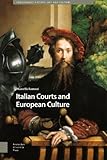Italian Courts and European Culture / Marcello Fantoni.
Material type: TextSeries: Renaissance History, Art and Culture ; 8Publisher: Amsterdam : Amsterdam University Press, [2022]Copyright date: ©2022Description: 1 online resource (306 p.)Content type:
TextSeries: Renaissance History, Art and Culture ; 8Publisher: Amsterdam : Amsterdam University Press, [2022]Copyright date: ©2022Description: 1 online resource (306 p.)Content type: - 9789048550944
- 945 23
- online - DeGruyter
| Item type | Current library | Call number | URL | Status | Notes | Barcode | |
|---|---|---|---|---|---|---|---|
 eBook
eBook
|
Biblioteca "Angelicum" Pont. Univ. S.Tommaso d'Aquino Nuvola online | online - DeGruyter (Browse shelf(Opens below)) | Online access | Not for loan (Accesso limitato) | Accesso per gli utenti autorizzati / Access for authorized users | (dgr)9789048550944 |
Frontmatter -- Table of Contents -- Acknowledgments -- Preface -- I. Republics and Princes -- 1. The Historiographical Journey -- 2. Historical Development -- 3. A World of Courts -- II. Italian Courts and European Culture -- 4. Europe of the Courts -- 5. People -- 6. Things -- III. The Models -- 7. The Spaces -- 8. Images -- 9. The Performing Arts -- 10. The Forma del Vivere -- IV. Common Denominators -- Conclusion -- Bibliography -- Index
restricted access online access with authorization star
http://purl.org/coar/access_right/c_16ec
Between the fifteenth and the eighteenth century, princely courts dominated the Italian political scene. These courts were effervescent centers of cultural production. As such, they became a model for European monarchies who imported Italian courtly forma del vivere (‘style of life’) to legitimize their power and to define social status. This phenomenon included architecture and painting, theater and music, manners and aesthetics, and all the objects, behaviors and beliefs that contributed to homogenize European culture in the age of the Old Regime. It involved a hemorrhage of art and a continuous circulation of people, texts and symbols. The foundational material for this process was classicism and its purpose was political. This delineates a new geography and chronology of a truly European cultural history. It also provides the key traits for the European cultural identity.
Mode of access: Internet via World Wide Web.
In English.
Description based on online resource; title from PDF title page (publisher's Web site, viewed 29. Mai 2023)


